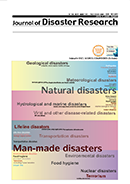19 巻, 1 号
選択された号の論文の21件中1~21を表示しています
- |<
- <
- 1
- >
- >|
Special Issue on Literacy for Disaster Resilience: Building a Societal Capacity for Reducing Disasters Due to Earthquake and Volcanic Eruption
-
原稿種別: Editorial
2024 年19 巻1 号 p. 17-18
発行日: 2024/02/01
公開日: 2024/02/01
PDF形式でダウンロード (356K) -
原稿種別: Paper
2024 年19 巻1 号 p. 19-29
発行日: 2024/02/01
公開日: 2024/02/01
PDF形式でダウンロード (18377K) -
原稿種別: Paper
2024 年19 巻1 号 p. 30-37
発行日: 2024/02/01
公開日: 2024/02/01
PDF形式でダウンロード (7118K) -
原稿種別: Paper
2024 年19 巻1 号 p. 38-49
発行日: 2024/02/01
公開日: 2024/02/01
PDF形式でダウンロード (19766K) -
原稿種別: Survey Report
2024 年19 巻1 号 p. 50-55
発行日: 2024/02/01
公開日: 2024/02/01
PDF形式でダウンロード (2467K) -
原稿種別: Paper
2024 年19 巻1 号 p. 56-71
発行日: 2024/02/01
公開日: 2024/02/01
PDF形式でダウンロード (3081K) -
原稿種別: Survey Report
2024 年19 巻1 号 p. 72-80
発行日: 2024/02/01
公開日: 2024/02/01
PDF形式でダウンロード (9677K) -
原稿種別: Paper
2024 年19 巻1 号 p. 81-93
発行日: 2024/02/01
公開日: 2024/02/01
PDF形式でダウンロード (1775K) -
原稿種別: Paper
2024 年19 巻1 号 p. 94-104
発行日: 2024/02/01
公開日: 2024/02/01
PDF形式でダウンロード (2186K) -
原稿種別: Survey Report
2024 年19 巻1 号 p. 105-112
発行日: 2024/02/01
公開日: 2024/02/01
PDF形式でダウンロード (11650K) -
原稿種別: Paper
2024 年19 巻1 号 p. 113-123
発行日: 2024/02/01
公開日: 2024/02/01
PDF形式でダウンロード (10611K) -
原稿種別: Paper
2024 年19 巻1 号 p. 124-138
発行日: 2024/02/01
公開日: 2024/02/01
PDF形式でダウンロード (8539K) -
原稿種別: Paper
2024 年19 巻1 号 p. 139-146
発行日: 2024/02/01
公開日: 2024/02/01
PDF形式でダウンロード (7140K) -
原稿種別: Survey Report
2024 年19 巻1 号 p. 147-153
発行日: 2024/02/01
公開日: 2024/02/01
PDF形式でダウンロード (23366K) -
原稿種別: Survey Report
2024 年19 巻1 号 p. 154-158
発行日: 2024/02/01
公開日: 2024/02/01
PDF形式でダウンロード (1298K) -
原稿種別: Paper
2024 年19 巻1 号 p. 159-172
発行日: 2024/02/01
公開日: 2024/02/01
PDF形式でダウンロード (8514K)
Regular Papers
-
原稿種別: Paper
2024 年19 巻1 号 p. 173-181
発行日: 2024/02/01
公開日: 2024/02/01
PDF形式でダウンロード (16394K) -
原稿種別: Paper
2024 年19 巻1 号 p. 182-191
発行日: 2024/02/01
公開日: 2024/02/01
PDF形式でダウンロード (8634K) -
原稿種別: Paper
2024 年19 巻1 号 p. 192-203
発行日: 2024/02/01
公開日: 2024/02/01
PDF形式でダウンロード (9636K) -
原稿種別: Paper
2024 年19 巻1 号 p. 204-213
発行日: 2024/02/01
公開日: 2024/02/01
PDF形式でダウンロード (19370K) -
原稿種別: Paper
2024 年19 巻1 号 p. 214-225
発行日: 2024/02/01
公開日: 2024/02/01
PDF形式でダウンロード (17783K)
- |<
- <
- 1
- >
- >|
